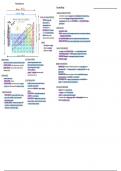Periodic table trends
Transition Metals
electron affinity *
ionisation
energy VARIABLE OXIDATION STATES
D
A A • when orbitals are occupies, the expulsion between electrons pushes 4s into a higher energy
METALLIC CHARACTERISTICS
state, so it becomes lightly higher in energy then 3d, losing its electron first
• METALS: 1-3 outer shell
• transition metal ions with +3 tend to be POLARISING, have a HIGH CHARGE Density and
Alkaline
metals vigorously
be * electrons, low IE, low
pull on electrons
-react Het d
electronegativities (due to
-
-
S
with halogens
h A
delocalised electrons COMPLEX IONS
• NON-METALS: 4-7 electrons in • central metal ion + ligand
h T character 8 outer shell, high electronegativity, • LIGAND: a molecule or ion that form complexes which consist of a central metal ion and ligands
E
+ E & high EA (tendency to share —> LEWIS BASE, NUCLEOPHILE
non-metallic
S -'
W
: character - i P
5
↑
electrons and form covalent bonds • CO-ORDINATION NUMBER: number of co-ordinate bonds to the central metal atom or ion
r - • NAMING COMPLEXES: prefix for number of ligands/ligands name/element/oxidation number
metallic
8
OXIDES:
-
d e • Na and Mg oxides are basic
V
=
• Al oxides are amphoteric CATALYTIC PROPERTIES
#
• Si to Cl oxides are acidic
• can catalyse certain REDOX REACTIONS —> can be readily oxidised and reduced
*
* • HETEROGENOUS catalyst has a different physical state (phase) from the reactants
atomic radius
# • HOMOGENOUS catalyst is the same physical state (phase) as the reactants
ELECTRON AFFINITY • BIOLOGICAL catalysts
ATOMIC RADIUS
• distance between nucleus of an atom & outermost electron shell • amount of energy released when 1 mole of
electrons is gained by 1 mole of atoms of gaseous MAGNETIC PROPERTIES
• ACROSS A GROUP: nuclear charge increases = greater pull
state to form gaseous ion (- charge) • DIAMAGNETISM: the property of all materials and produces a very weak opposition to an
• DOWN A GROUP: increase in number of shells, increase in
• first EA = exothermic applied magnetic field —> from repulsion of electrons to the applied magnetic field, create a tiny
shielding, weak pull
• second EA = endothermic (overcoming repulsion magnetic dipole
between electrons and - ion) • PARAMAGENTISM: only occurs in substances which have unpaired electrons, produces
IONIC RADIUS
magnetism proportional to the applied field in the same direction
• measure of size of an ion
• FERROMAGNETISM: the alignment of the unpaired electrons in an external field can be
• DOWN A GROUP = increases ELECTRONEGATIVITY
retained so that material becomes permanently magnetised
• ACROSS A PERIOD: ionic radii increases with an increase • the ability of an atoms to attract a pair for electrons
in - charge, ionic radii decreases with an increase in + charge towards itself in a covalent bond
COLOURED COMPOUNDS:
• arises form the + nucleus ability to attract - charged
• d-block elements have unpaired electrons
electrons
IONISATION ENERGY • the d-orbitals are split into two energy levels
• PAULING SCALE - assigned electronegativity value
• DOWN A GROUP= increase in nuclear charge, increase in • electrons can transition between these energy levels
• FLUORINE most electronegative
shells, increase in shielding, increase in atomic radius, • in the meantime they can absorb energy form light at a visible wavelength and thus, one can
• DOWN A GROUP = negligible nuclear charge increase,
electrons held more loosely observe the complimentary colour
increase in shielding, increase in atomic radius, decrease
• ACROSS A PERIOD = increase in nuclear charge, shells
in attraction of nucleus and electron
remain the same, shielding remains constant, decrease in
atomic radius, electrons held more tightly




